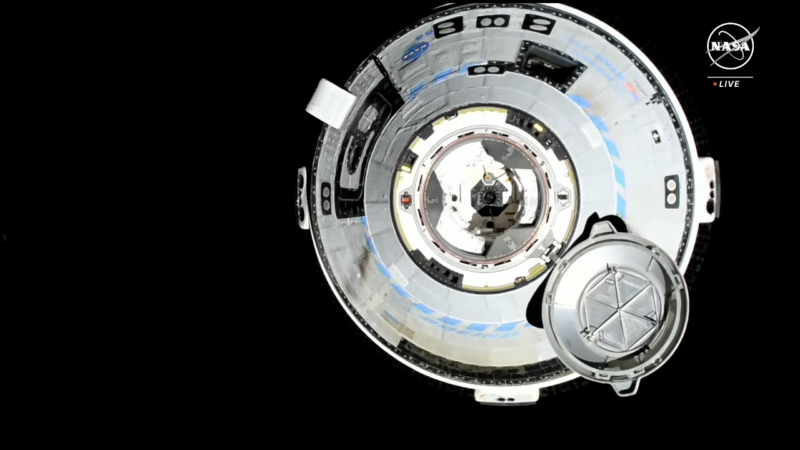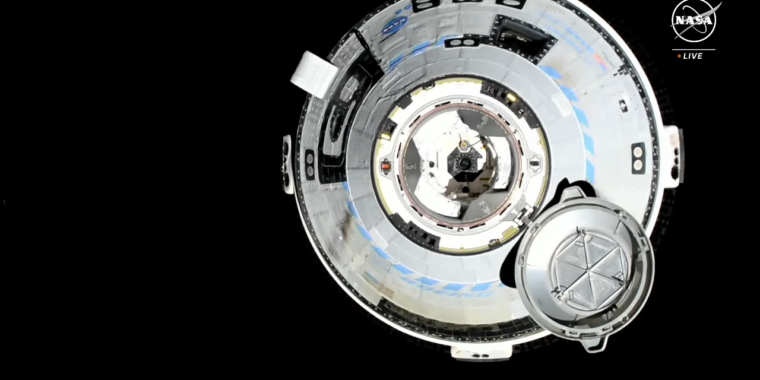
NASA TV
NASA and Boeing will take an additional four days to review all available data about the performance of the Starliner spacecraft before clearing the vehicle to return to Earth, officials said Tuesday.
Based on the new schedule, which remains pending ahead of final review meetings later this week, Starliner would undock at 10:10 pm ET on Tuesday, June 25, from the International Space Station (02:10 UTC on June 26). This would set up a landing at 4:51 ET on June 26 (08:51 UTC) at the White Sands Test Facility in New Mexico.
During a news conference on Tuesday, the program manager for NASA’s Commercial Crew Program, Steve Stich, said the four-day delay in the spacecraft’s return would “give our team a little bit more time to look at the data, do some analysis, and make sure we’re really ready to come home.
Working two major issues
NASA is still trying to clear two major hardware issues that occurred during the spacecraft’s flight to the International Space Station nearly two weeks ago: five separate leaks in the helium system that pressurizes Starliner’s propulsion system and the failure of five of the vehicle‘s 28 reaction-control system thrusters as Starliner approached the station.
Since then, engineers from NASA and Boeing have been studying these two problems. They took an important step toward better understanding both on Saturday, June 15, when Starliner was powered up for a thruster test.
During this test, engineers found that helium leak rates inside Starliner’s Service Module were lower than the last time the vehicle was powered on. Although the precise cause of the leak is not fully understood—it is possibly due to a seal in the flange between the thruster and manifold—the lower leak rate gave engineers confidence they could manage the loss of helium. Even before this decrease in the leak, Starliner had large reserves of helium, officials said.
The test of the reaction control system thrusters also went well, Stich said. Four of the five thrusters operated normally, and they are expected to be available for the undocking of Starliner later this month. These thrusters, which are fairly low-powered, are primarily used for small maneuvers. They will also be needed for the de-orbit burn that will set Starliner on its return path to Earth. Starliner can perform this burn without a full complement of thrusters, but Stich did not say how many could be safely lost.
First operational mission when?
NASA is being cautious about Starliner because this is the first crewed flight of the vehicle, which NASA funded to provide transportation services to the International Space Station. The goal is to provide regular flights of four astronauts to the space station for six-month rotations. This initial test flight, carrying NASA astronauts Butch Wilmore and Suni Williams, is intended to provide data to certify the vehicle for operational missions.
The first opportunity for Boeing to fly one of these operational missions is early 2025, likely in February or March. NASA will soon need to decide whether to give this slot to Starliner or SpaceX’s Dragon vehicle for the Crew-10 mission—NASA’s 10th operational flight on Dragon.
Given the technical problems that cropped up on the current test flight, it seems likely that NASA will push Starliner’s operational mission to the next available slot, likely in August or September of 2025. However, Stich said Tuesday no decision has been made and that NASA needs to study the results of this test flight.
“We haven’t looked too much ahead to Starliner-1,” he said. “We’ve got to go address the helium leaks. We’re not gonna go fly another mission like this with the helium leaks, and we’ve got to go understand what the rendezvous profile is doing that’s causing the thrusters to have low thrust, and then be deselected by the flight control team.”
Although Starliner’s first crewed flight has challenged NASA and Boeing, Stich said the process has not been frustrating. “I would not characterize it as frustration,” he said Tuesday. “I would characterize it as learning.”

